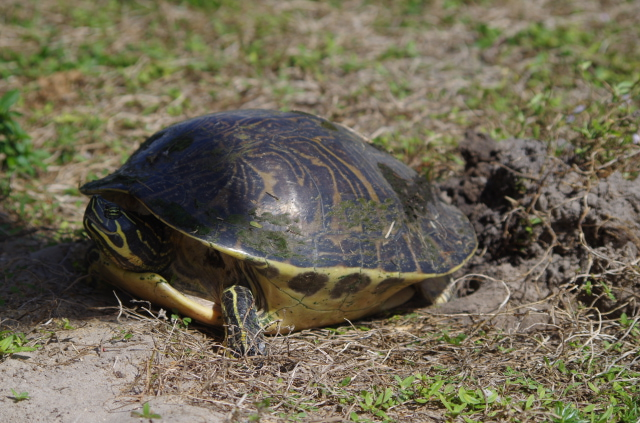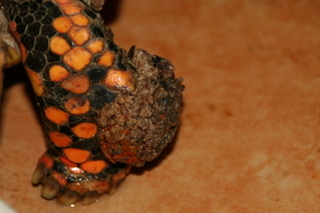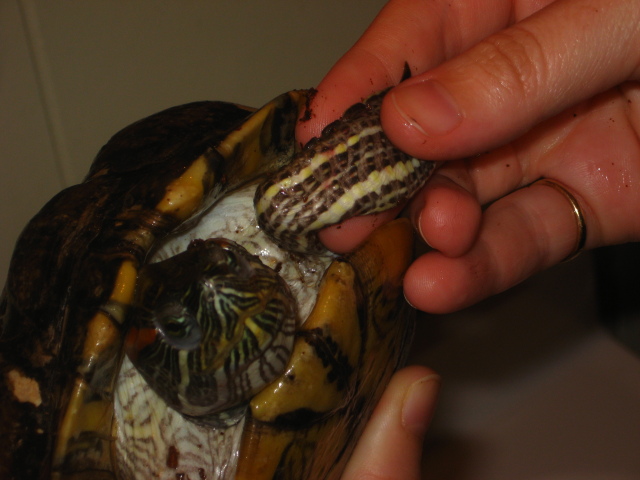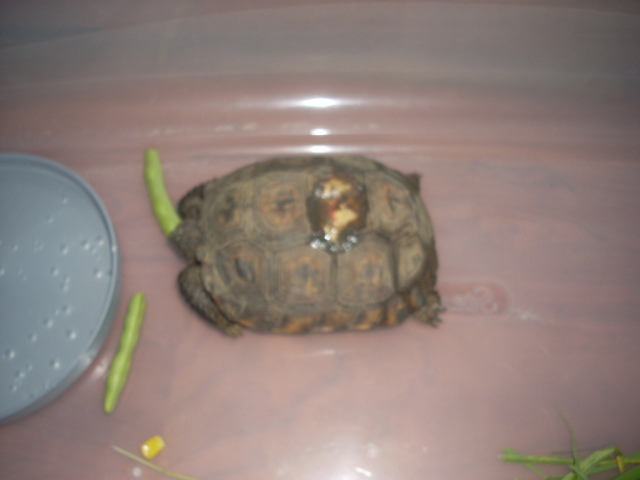QuestionHI, YESTERDAY I PURCHASED A RED EARED SOMETHING TURTLE, CAN YOU PLEASE GIVE ME SOME BIGINER TIPS, WHY WONT HE EAT YET AND WHEN WILL HE HE HAS NOT EATEN FOR 3 DAYS? HOW DO I FEED HIM AND WHAT? CAN YOU ALSO GIVE ME SOME OTHER IMPORTANT TIPS WHICH I SHOULD KNOW ABOUT, AND HOW A HEALTHY ENVIORMENT IS SUPPOSED TO BE FOR THEM. THANK YOU SO MUCH! YOU SEEM TO BE THE ONLY ONE IN THIS DEPARTMENT WHICH KNOWS WHAT HE IS TALKING ABOUT, I TOO AM ON THIS WEBSITE AS A VOLENTEER IN THE FISH SECTION AND I REALLY DONT KNOW MUCH ON MY TURTLE. THANK YOU SO MUCH!!!!
AnswerWhy hasn't it eaten? Possibly due to simple stress, but it may be other things. Don't worry too much right now, however. If your turtle feels 'hefty' or has some weight for its size, it will be OK- they can go quite a long time without food if other conditions are OK.
Next, let me share my fave turtle website- you'll get a ton of good info and links here: www.tortoise.org.
Now, since you are also a voilunbteer here, I think I can tell you that you broke the Prime Directive of Pet Ownership: "Never buy a pet without knowing what you are getting into."
Turtles are an odd category. Pond turtles, like the Red-ear and Painted turtles are, in many ways, a lot harder than fish to care for. You need stronger filtration to deal with the messy eating, you need to manage the lighting differently and you have the problems of trying to run an aquarium and a terrarium in one, AND you've bought a pet with a lifespan of about 20 years of you take care of it well, but most owners will only have them for about 5 for a wide variety of reasons.
So- a bsic primer on basic pond turtle care:
HOUSING: Other than size and ease of cleaning, there is no special requirment for the tank. In fact, many people use large plastic tubs or childrens wading pools! The size requirements run about 5 gallons of water to start for a baby turtle (not a 5 gallon tank 1/2 filled- 5 gallons minimum of free, open swimming space for proper exercise.) As a rule of thumb, add another couple gallons for every inch long the turtle's shell is.
Turtles do not require pool decor, but any that is used needs to be tough enough to tolerate active, heavy turtles- they will knock over simple weighted plants in a heartbeat, for example.
Pond turtles in normal conditions do not require any special substrate, either.
They DO require a basking area, and will sometimes apreciate some dry land space. The 'crawl out' needs to be easy to climb, good texture, able to absorb a bit of heat fom the overhead heating, and be bone dry most of the time. Driftwood planks or wide, flat pieces work well, as do things like rubber mats, unglazed but smooth stone tiles, and so forth. What does not usually work are glass, glazed ceramics, plastics, etc. Minimum land space is enough for the turtle to get totally out of the water and move around freely on.
LIGHTING and HEATING
Arrange your tank so water temps range in the 60s (night-time cool space lows) to the 80's, with as much variety in the tank as possible (equal temps overall prevent the turtle from regulating its temps by changing locations.
Arrange for a basing area with temps that hit the 90's during the hot 'noon'. The best lighting and heating uses several bulbs on timers to simulate a normal day- soft dawn, warming at noon, peaking at about 2, dimming at dusk with about 10 hours of light every day.
Example:
8 am- flourescent light clicks on. This provides a gentle dawn and the 'cooler' lighting coolers.
10 am- kick on some incandescent bulbs, the number and wattage to be determined by the tank size. Brightness is NOT the key issue, however. These bulbs add a bbit of warmth (but not much) and more importantly, add the warm colors to the light spectrum.
11 am- an infra-red heating bulb kicks on over the basking area. Besides the basking heat, this also provides infrared light for the color mix.
1 pm- Ultra-violet (black) light over the basking area. This adds heat, and UV light which helps the turtle manufacture Vitamin D. At this point, we have about the same color quality as natural sunlight in our tank.
2 pm- turn off the UV.
5 pm- turn off the IR.
7 pm- turn off incandescent.
8 pm- turn off flourescent.
Besides this, you will probably need a water heater- make sure it is rated correctly for the tank type AND protect it from being bumped or bashed by curious and heat-seeking turtles.
FOOD
Younger turtles are carnivores, and become more vegetarian as they age. At NO point will they eat things like dried ants or flies (popular in cheap mixes), hamburger (fatty and the wrong kind of meat) or lettuce (vitamin/nutrient deficient).
For younger turtles, try brine shrimp, tubiflex worms, trout chow, quality turtle foods, guppies and small goldfish, earthworms, etc. As they get larger, they will appreciate things like spinach and greens more than the 'live' foods, but trout chow and good food mixes will still be appreciated.
Offer a variety and also vary quantities- normal days, light days, fasting days, treat days, etc. Remove uneaten food after about 15-20 minutes, and ot keep your main tank clean, feed them in a smaller, easy to clean tank and keep them there for about an hour after feeding.
OTHER TIPS:
- Diluted bleach is an efective, and reptile-safe disinfectant.
- Salmonella is a real concern. Learn about it and practice good handwashing.
- Sights and vibrations will stress the turle. Keep it somewhere where these are kept to a manageable level. Leaning over the open top of a tank, for example, scares the turtle... until it learns to associate that with food!
- EVERYBODY has a different opinion on the best way to raise turtles. The main lesson from this is that these things are pretty hardy as long as they are decently cared for.
- Turtles are reasonably intelligent and can often come to learn to associate you with food, AND most turtles like being stroked/massaged on the top of their head- once they get used to being picked up (which you should not do TOO often!)
- As you get used to the turtle, its own behavior will help you learn more- is it hanging out in the cool area? Turn down the heat a bit. Is it not eating a favorite treat? Check conditions carefully. Is it laying eggs? It is probably a female :-)
Good luck, and be sure to check out www.tortoise.org!

 Peninsula Cooter laying eggs
QuestionPeninsula Cooter
QUESTION: I have just w
Peninsula Cooter laying eggs
QuestionPeninsula Cooter
QUESTION: I have just w
 flakey substance on turtles neck and legs
Question
Red ear slider
red ear slider about 9 mos. 20
flakey substance on turtles neck and legs
Question
Red ear slider
red ear slider about 9 mos. 20
 Warts issue
Question
warts issue
Does the attached picture match a
Warts issue
Question
warts issue
Does the attached picture match a
 red eared slider shell rot
Question
turtles leg
We have a red eared slider, about
red eared slider shell rot
Question
turtles leg
We have a red eared slider, about
 Turtle found in yard
Question
Turtle
My son ran over a turtle in our yard to
Turtle found in yard
Question
Turtle
My son ran over a turtle in our yard to